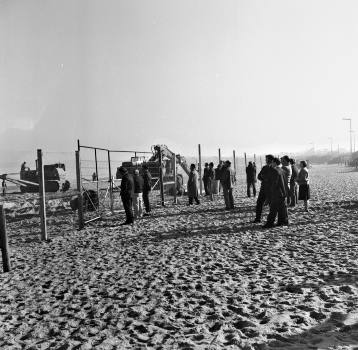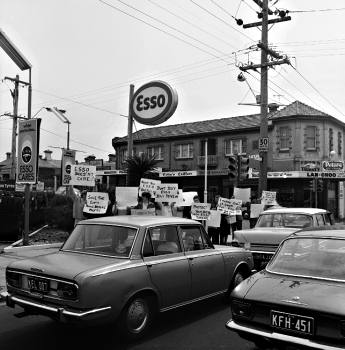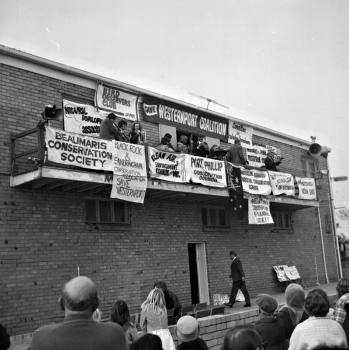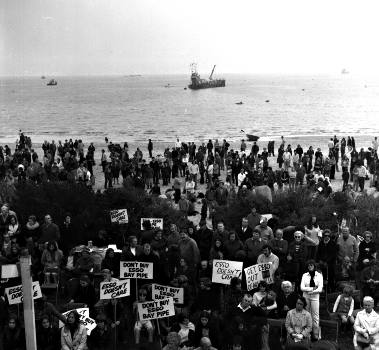No Pipeline Across the Bay

Protesters on the Mordialloc Beach watching work in progress. Courtesy Leader Collection.
At the beginning of 1971 the Mordialloc Council protested to the Minister of Fuel and Power about a proposal by Esso to lay a pipeline across Port Phillip Bay from Mordialloc. The ten inch pipeline, which was to carry ethane gas, was believed by many people to be detrimental to the environment. The councillors supported this view but the Minister could not see any reason for the councillors to be worried He offered to receive a deputation to discuss the matter. [1]
In August of the previous year the Mordialloc Council, although opposed to the pipeline, set down the conditions which the pipe-laying company would be asked to observe should the project proceed. However, they decided not to pass this information on to the company or the Minister, believing it would weaken their case of opposition.
The issue stirred the emotions of many people and received the attention of the trade union movement who initially imposed a ban on unionists taking part in the laying of the ethane pipeline under the bay from Mordialloc to Altona. But by July of 1971 the Trades Hall Council had withdrew its ban on members working on the project. Mrs Igguldendn, secretary of the Port Phillip Conservation Council, was saddened by the decision, adding that she believed both the government and the Trades Hall Council had “sold out to big business.” There were twenty six unions, however, who maintained their stance of opposition. Known as the ‘rebel’ unions, their spokesman, Ken Carr, said “Even the slightest risk is too big a danger. Until we are totally convinced the ban will stay.” [2]
Mr Court, speaking for the Minister of Fuel and Power, praised the decision of the Trades Hall Council and pointed out the bay option was not cheaper than a land option but it would cause less inconvenience to the public. In the unlikely event of a leak it would be safer, Court claimed. He added, that there was no proof that there was an ecological problem, nor was there a logical argument for not going across the bay. [3] Court also pointed out that two improvement programs would be undertaken when the pipeline was laid. One was to create artificial reefs across the bed of the Bay to attract marine life back to the ‘ecologically dead’ areas, and the other was to remove the sandbank at the mouth of the Mordialloc Creek. [4] The Anti Bay-Pipeline Committee, while favouring artificial reefs to stimulate fish breeding, were strongly opposed to artificial reefs created from old tyres as was being proposed. To dump any artificial ‘reef’ into a quagmire of mud and refuse collected over 150 years from ‘civilization’ is ludicrous, M Wallace-Mitchell, Vice-president of the committee, argued. [5] He went on to explain it was not the ethane contents of the pipeline they were concerned about but the ‘legal precedent’ the project created. “What will come next,” he asked. “Will it be turpentine or kerosene? The present day reassurances of politicians and public servants are no safeguards for tomorrow,” he claimed.
Three months later, in October 1971, work on the pipeline started. The crew of the work boat, Carole Ingram, began a coring and sampling operation on the foreshore and in the water off Mordialloc. A deputation to Mr Hamer to stop the work proved fruitless as he confirmed the pipeline would be laid. This stirred the Friends of the Earth to organise a protest at a garage in Brighton arguing that Esso as one of the largest corporations in the world should not be allowed to take public property for a pipeline. The Bay belongs to the people the Friends suggested. [6] The 26 rebel unions continued to support the environmentalists with their secretary, Ken Carr, indicating, “We will use every means at our disposal to ensure that no pipelines go under the bay.” [7]

Protestors at an Esso garage in Brighton. Courtesy Leader Collection.
Esso-BHP organised several displays to demonstrate the harmless nature of ethane gas to the natural environment. These displays at RMIT, Southland and in several local banks had gas bubbling through tanks of water in which fish were apparently contentedly swimming. Conservationalists suggested the gas being used was propane not ethane so the demonstration proved nothing. Cr Malcolm Buxton pointed out that the pipeline might not always carry ethane and the construction of the pipeline under the Bay created an unwanted precedent. [8] He pressed his colleagues to support council by writing to the Minister asking six questions.
Who are the contractors and when will work begin? Is Crib Point engineering constructing any sea going craft for this job? What experience have the contractors had in laying under sea pipelines? Where are the pipes being assembled and how will they be put into the bay? Have the terms of licence been altered and if so, why? And is ‘scab’ labour being used by the contractor for the work?
Cr Denyer was concerned about the aggressive nature of the proposed letter but Cr Buxton said they could not afford to be ‘wishy washy’ about this affair. “If we just sit back and ask polite questions we’ll get nowhere,” he said. Buxton got his way although the words ‘scab labour’ were amended to the less partisan phrase “non union labour’ before the motion was passed. [9]
Mr Balfour was not impressed by the Mordialloc Council’s actions. He pointed out that the Council had first objected to the pipeline in December 1969 but since that time the Council has refused to join in discussions about the most suitable route for the pipeline, despite a considerable amount of correspondence and repeated requests. Because of this lack of cooperation the Minister went ahead and published the proposed changes to the route in the daily press without consulting Mordialloc Council, and invited people to inspect them at the Ministry Offices. The Council did not take up this offer.
Cr Denyer was not surprised by the Minister’s actions. The Minister had become sick and tired of asking Council for suggestions and he could not be blamed for his attitude, he said. Cr Peter Scullin, a newly elected councillor, expressed his amazement and disappointment at the Minister’s attitude. But Denyer replied, “Our attitude to negotiation offers, rightly or wrongly, have been negative.” For eighteen months the council refused to allow its officers to discuss the pipeline and its route through the city with any Esso or Ministry official. By this means the council hoped to thwart the pipeline proposal but they failed in achieving this goal. [10]
The conservationists and some of the rebel unions were not so daunted. Two of the unions, the Boilermakers’ Society and the Blacksmith’s Union, withdrew their opposition in order to facilitate their amalgamation with another union. But others proceeded with their plans to hold a series of factory meetings so that union members could be informed of the latest developments. In addition, public meetings were arranged. The first was held in the Black Rock Community Hall and the second was on the foreshore at Mordialloc. This latter rally was called “Banana Republic Day” with the theme “ The sell out to foreign interests by the Government of Victoria.” A jazz band, folksingers and a calypso singer provided the entertainment. While Arnold Luby, the secretary of the Anti Bay Pipeline Action Committee, accepted the environmentalists had their backs to the wall, he warned local politicians who were not supporting the campaign that while they may be roosters today, tomorrow they would be feather dusters unless they corrected their stance. [11]

Protesting Groups Gather at Mordialloc to Rally Support. Courtesy Leader Collection.
Ted Bull, the president of the Waterside Workers’ Federation, likened the oil company’s attack on the environment and the laying of the pipe to mass murder. He also objected to the presence of more than fifteen uniformed policemen with an inspector and three sergeants as well as a number of plain clothes men. “The police are here in all their glory, being paid by us to protect foreign investment,” he said. Initially the police took up positions near the pipeline survey marker on the beach and told several people to keep away. However, later in the day, they stood by and watched it being torn up. At the close of the meeting Cr Peter Scullin engaged in the dramatic gesture of placing the Australian flag on top of the oil company’s up-turned survey marker. This was done to the amusement and encouragement of the crowd. [12]
Gareth Clayton, standing as the Australian Labour Party’s candidate for the State parliamentary electorate of Isaacs, took the opportunity to enter the debate and express his views by writing in the local paper. While acknowledging the pipeline question was important, he saw the more significant issue as being one of a conflict between “an American capitalist giant and the will of the people.” He decried the harm the pipeline would do to the marine environment and recommended that a land corridor be set aside around Melbourne to take this and all future pipelines. [13] The following week in the same paper, Harley Klauer of Seaford, who claimed no political party allegiance, challenged Clayton’s views and wondered, “where Mr Clayton had obtained all this ‘farm fresh’ stockyard confetti.” He dismissed the idea that the marine environment would be damaged as “the mud and silt would settle over night” and contrasted the damage that would be done to the natural bushland and private properties should the notion of a land corridor for pipelines be adopted. [14]. Gareth Clayton in his reply suggested Mr Klauer misunderstood the land route corridor concept as it did not necessarily mean the destruction of natural bushland as roadways could be used. [15]
School students also entered the debate. About one hundred and ninety pupils from Aspendale Technical School signed a petition which was sent to the Minister for Fuel and Power. They asked him to change his decision and not allow the pipeline across the bay. While fearing the damage the pipeline would do to the environment, they also believed there was a danger to people as the trench in which the pipeline was placed could collapse and trap people. Minister Balfour in his letter reassured the students that the pipeline was being constructed to the highest international standards and once it was completed the trench would be filled and the area fully restored. [16]
The Mordialloc Council at this point seemed to change its tack, becoming more concerned about the damage and the loss of revenue caused by the ethane gas pipeline being routed through the municipality. They wanted the Minister to act on their behalf to open negotiations with the company but the Minister refused. Minister Balfour said he was not interested in entering as an intermediary in the argument or arbitrating discussions between Esso Australia Limited and the Council, although the Council maintained he had previously agreed to do so. Despite Council’s protestations, he maintained his position that the Council had to initiate discussion with the company and come to some agreement. He pointed out, it was only the company that could make any form of payment to council in relation to compensation. It was not a matter for government. Cr Peter Scullin described the Minister’s action as “an incredible about-face”. Opening this discussion was difficult for the Council given their negative stance on the pipeline. [17] The Minister did acknowledge that he had a responsibility to see the area satisfactorily restored and in his judgement that had been done. Furthermore, he went on to advise that he knew of no grounds such as ‘loss of enjoyment and use of public parkland” on which a legitimate claim for compensation could be substantiated as no buildings or permanent structures were disturbed or trees removed. [18]

Protesters gather on Mordialloc Beach with the Work Boat in the Background. Courtesy Leader Collection.
By December 1972 the pipeline across Port Phillip Bay was completed after about five and a half months work and ethane gas was being pumped through it. The forty-nine-mile pipeline, running between Mordialloc and Altona, was tested for safety by pumping water through it at 2000 lb pressure per square foot. This was achieved without trouble. This result encouraged the company’s spokesman to point out the ethane would be pumped through at only 400 lb pressure per square foot. [19]
The pipeline that was opposed by thousands of people attending public meetings, its construction curtailed by black bans imposed by trade unions and the strong and persistent opposition by the Mordialloc Council, was completed. It continues to operate today and as far as is known has done so without incident for over thirty years. Any destruction of marine life due to its presence has not been publicly documented. Today its presence is noted by signs warning people of its existence, but its location and history is unknown to the vast majority of people enjoying the beach sands of Mordialloc.

Notice in the Hazel Pierce Park warning people that a gas pipeline is below the surface, 2004.
Footnotes
- Mordialloc Chelsea News, February 17, 1971.
- Mordialloc Chelsea News, July 7, 1971.
- Mordialloc Chelsea News, July 7, 1971.
- Mordialloc Chelsea News July 7, 1971.
- Mordialloc Chelsea News, November 10, 1971.
- Mordialloc Chelsea News, October 6, 1971.
- Mordialloc Chelsea News, December 15, 1971.
- Mordialloc Chelsea News, December 15, 1971.
- Mordialloc Chelsea News, March 8, 1972.
- Mordialloc Chelsea News, May 3, 1971.
- Mordialloc Chelsea News, May 31, 1972.
- Mordialloc Chelsea News, June 21, 1972.
- Mordialloc Chelsea News, July 5, 1972.
- Mordialloc Chelsea News, July 12, 1972.
- Mordialloc Chelsea News, August 9, 1972.
- Mordialloc Chelsea News, August 2, 1972.
- Mordialloc Chelsea News, August 23, 1972.
- Mordialloc Chelsea News, August 30, 1972.
- Mordialloc Chelsea News, December 20, 1972.
